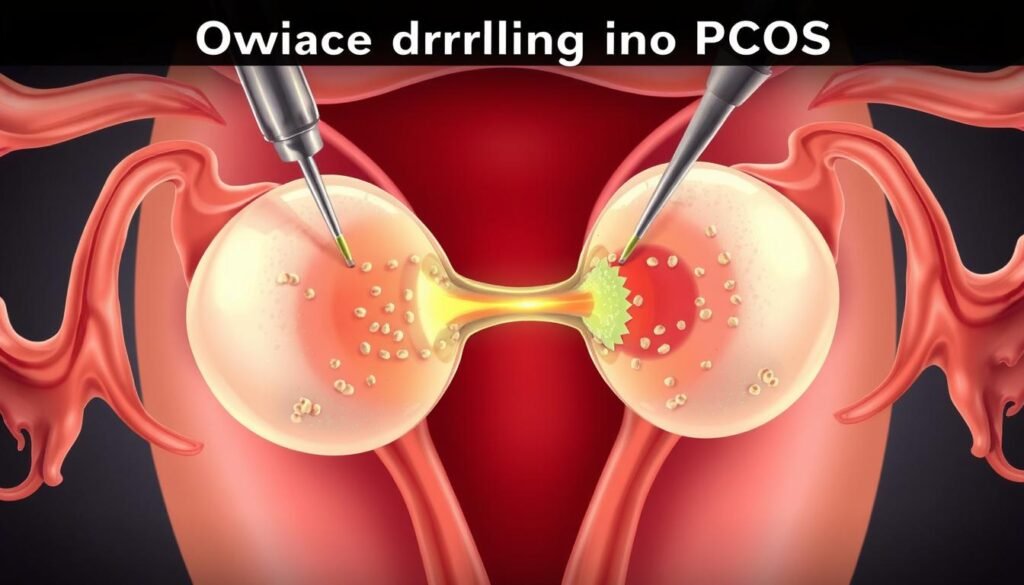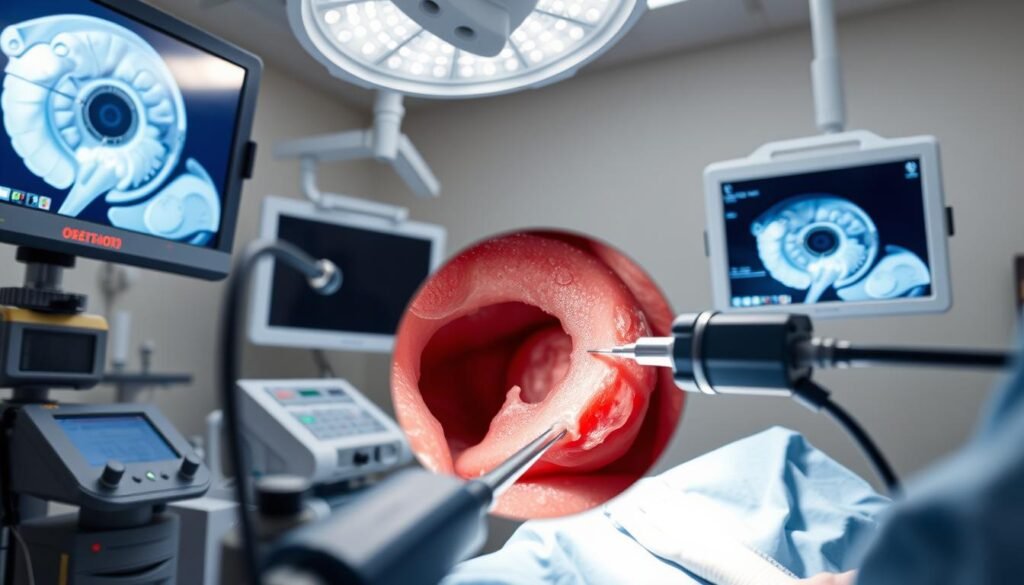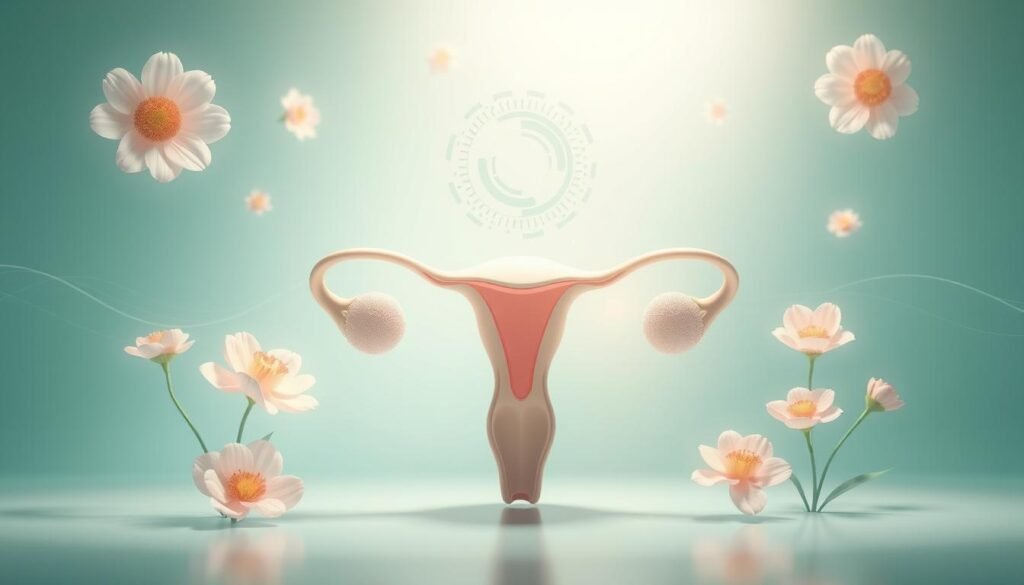About 1 in 10 women of reproductive age have Polycystic Ovary Syndrome (PCOS). This condition leads to irregular periods and makes it hard to get pregnant. Ovarian Drilling to Treat PCOS is a surgery that aims to balance hormones and improve ovulation. This method cuts into the ovarian tissue. It offers hope to women facing PCOS and wanting to become pregnant. For more info, check out Polycystic Ovary Syndrome Treatment.
Key Takeaways
- Ovarian drilling is a procedure specifically targeting PCOS symptoms.
- It helps improve hormonal balance and ovulation.
- The treatment can enhance fertility outcomes for women.
- Understanding the risks is essential for informed decisions.
- Post-procedure care is crucial for successful recovery.
Understanding Polycystic Ovary Syndrome (PCOS)
Polycystic Ovary Syndrome is a widespread hormonal disorder. It affects many women in their childbearing years. Knowing the PCOS symptoms and causes is crucial for its management and treatment.
Overview of PCOS Symptoms
Polycystic Ovary Syndrome symptoms can differ greatly. Common PCOS symptoms include:
- Irregular menstrual cycles
- Excessive hair growth on the face and body (hirsutism)
- Weight gain or obesity
- Acne and oily skin
- Thinning of hair on the scalp
These symptoms may cause emotional pain. They can greatly affect a woman’s life quality.
Causes and Risk Factors of PCOS
The exact causes of PCOS are still partly unknown. However, genetics, lifestyle, and the environment might trigger it. Some known risk factors include:
- Obesity, linked to insulin resistance
- Family history of PCOS or other endocrine disorders
- High insulin levels, disrupting hormonal balance
Understanding these factors is important. It helps individuals seek the right treatment and make lifestyle changes to manage PCOS effectively.
What is Ovarian Drilling?
Ovarian Drilling is a key option for women with Polycystic Ovary Syndrome (PCOS). It aims to boost ovulation by removing excess ovarian tissue. This helps correct hormone imbalances. Many women see their PCOS symptoms improve with this minimally invasive method.
Definition and Process of Ovarian Drilling
Ovarian Drilling involves making tiny holes in the ovaries. It uses tools like lasers or electrosurgical instruments. This can help balance hormones and promote ovulation.
The surgery is done with small cuts, using a technique called laparoscopic ovarian drilling. It’s known for quick recovery and less pain after the operation. A camera helps the surgeon see the ovaries clearly, making the surgery safe and precise.
Types of Ovarian Drilling Procedures
There are several kinds of ovarian drilling, each with its own benefits. Here are some common methods:
- Laparoscopic Ovarian Drilling – Uses tiny incisions for less pain and speedy recovery.
- Ovarian Diathermy – Employs heat to remove excess ovarian tissue, helping balance hormones.
- Laser Drilling – A precise method that uses laser energy to target cysts effectively.
How Ovarian Drilling to Treat PCOS Works
The mechanism of ovarian drilling is key in treating polycystic ovary syndrome (PCOS). It offers deep insights into making hormonal levels better and starting ovulation.
Mechanism of Action
Ovarian drilling is a surgery that cuts down the part of the ovary making too much androgen. This is vital for fixing the hormone issue often seen in PCOS patients. By focusing on the ovaries, this surgery changes hormone levels. This helps kickstart the ovaries back to normal, boosting the chances of regular ovulation and better fertility.
Hormonal Balance and Ovulation
Getting hormones balanced is crucial for healthy ovulation. Many with PCOS have irregular or no periods because of unbalanced hormones. Ovarian drilling helps the ovaries work better. This leads to more regular ovulation, helping those who want to get pregnant. Also, studies mention vitamin E supplementation might help manage PCOS by improving health.

| Factors | Before Ovarian Drilling | After Ovarian Drilling |
|---|---|---|
| Hormonal Balance | Typically Imbalanced | More Balanced |
| Ovulation Frequency | Irregular or Absent | Regular |
| Symptom Severity | Severe Symptoms | Reduced Symptoms |
The Role of Laparoscopic Ovarian Drilling
Laparoscopic Ovarian Drilling (LOD) is a key method for treating polycystic ovary syndrome (PCOS). It’s a less invasive option compared to traditional surgeries. It’s important to know how this technique helps patients and improves their health.
Benefits of Laparoscopic Techniques
Many women with PCOS are searching for good treatment options. Laparoscopic methods have several benefits. Some of these are:
- Shorter recovery times, so patients can get back to their lives sooner.
- Less pain after surgery, making the recovery easier to handle.
- Only small scars, which is less worrying for many patients.
- More precise surgery, which leads to better results.
- Less time needed in the hospital, making things more comfortable.
These advantages make Laparoscopic Ovarian Drilling a preferred choice for women facing PCOS. For more info about how effective this technique is, check out this study.
Comparison with Traditional Surgical Methods
Traditional ovarian drilling often requires open surgery. This usually means longer recovery and more risks. Below is a table showing how the two methods compare:
| Feature | Laparoscopic Ovarian Drilling | Traditional Ovarian Drilling |
|---|---|---|
| Recovery Time | Shorter (Days) | Longer (Weeks) |
| Postoperative Pain | Less Severe | More Severe |
| Scars | Minimal | Larger |
| Precision | Higher | Lower |
| Hospital Stay | Shorter | Longer |
This table clearly shows why Laparoscopic Ovarian Drilling is favored by many doctors. With fewer risks, it’s a better option for managing PCOS well.

Benefits of Ovarian Drilling for PCOS
Women with polycystic ovary syndrome (PCOS) often deal with hormonal imbalances and irregular periods. Ovarian drilling can help solve these issues. It brings several benefits that improve reproductive health.
Addressing Hormonal Imbalance
Ovarian drilling effectively tackles hormonal imbalance. It lowers the excess testosterone which causes PCOS symptoms. With balanced hormones, women might see less acne and hair growth. They also may have more regular menstrual cycles.
Improving Fertility Outcomes
Ovarian drilling has a big effect on fertility. Many women find their fertility improved after the procedure. About 50% of women could get pregnant within a year post-surgery. This boosts their chances to start or grow a family.
Effects on Irregular Periods
Many women with PCOS struggle with irregular periods. Ovarian drilling helps regulate menstrual cycles. It makes small holes in the ovaries, leading to consistent ovulation. For those with unpredictable periods, this can make a huge difference.

The benefits of ovarian drilling go beyond fertility and period regulation. Knowing the advantages equips women with PCOS to make better health decisions.
Potential Risks and Considerations
Ovarian drilling can help those with Polycystic Ovary Syndrome (PCOS), but it has risks. It’s vital to talk with your doctor about these risks. This helps in making an informed decision about Ovarian Drilling.
Common Risks Associated with the Procedure
Ovarian drilling, like any surgery, has potential risks. Some common complications include:
- Infection at the surgery site
- Heavy bleeding during or after surgery
- Damage to nearby tissues, affecting other reproductive organs
- Adhesions that may impact future fertility
Long-term Health Implications
There are significant long-term health issues to consider. Ovarian scarring can influence future attempts at pregnancy. It’s important to talk about how this surgery might affect future pregnancies and your reproductive health.
Understanding PCOS is key to improving fertility outcomes. Treatments, such as medications or lifestyle changes, can help alongside surgery. For more on managing PCOS-related fertility problems, visit this resource.
Post-Procedure Recovery and Care
After ovarian drilling, understanding the recovery process is key. This period lets the body heal and adjust after the procedure. Each patient may go through different experiences that help their recovery.
Expected Recovery Timeline
Most women can get back to their usual activities in just a few days. The beginning may bring some discomfort or cramps. These can usually be eased with pain relievers found at the store.
As time goes on, patients can slowly do more activities. But, heavy exercises should be avoided for a few weeks. The time it takes to fully recover varies. Yet, many feel their normal energy levels come back within a week.
Follow-Up Care and Monitoring
Follow-up care is crucial after ovarian drilling. It helps keep track of how the ovaries are doing and the hormonal balance. Often, check-ups are set a few weeks after to see how effective the procedure was.
During these visits, doctors may check menstrual cycles and hormone levels. This regular check ensures any issues can be caught and handled early. It helps achieve the best long-term results for recovery.
Weight Management and Insulin Resistance
Managing your weight well is key if you have PCOS. Being overweight can make symptoms worse and increase insulin resistance. This can start a cycle that makes the condition harder to deal with. By focusing on weight management, women can greatly improve their health and lessen PCOS symptoms.
Impact of Weight on PCOS Symptoms
Weight impacts your hormones, possibly leading to higher insulin levels and more PCOS problems. Studies show that losing even a little weight can help a lot. It makes menstrual cycles more regular and lowers androgen levels. This shows how closely weight and insulin resistance are linked in dealing with PCOS.
Strategies for Managing Insulin Resistance
To tackle insulin resistance, a combination of lifestyle changes and medicine is often needed. Here are some strategies:
- Adopting a balanced diet rich in whole grains, lean proteins, and healthy fats
- Exercising regularly, like brisk walking or resistance training
- Keeping track of carbs to help control blood sugar
- Talking to doctors about medicine for insulin management
These methods work well with other PCOS treatments, such as ovarian drilling. Together, they form a full plan for fighting the condition.
Conclusion
Ovarian drilling offers hope to women fighting PCOS. It balances hormones, improving fertility and easing PCOS symptoms. It’s a pathway to a better life for those affected.
This treatment works best when combined with a healthy lifestyle. Eating right and exercising are key. Together with medical care, they enhance well-being.
In short, ovarian drilling is a valuable treatment for PCOS. It tackles hormonal issues head-on. Knowing its benefits and combining it with lifestyle changes can greatly help women.